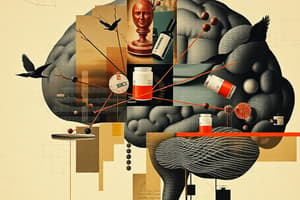Podcast
Questions and Answers
What is the primary function of Norepinephrine Transporter (NET) Inhibitors?
What is the primary function of Norepinephrine Transporter (NET) Inhibitors?
- To increase the release of norepinephrine
- To inhibit Monoamine Oxidase
- To decrease the reuptake of norepinephrine (correct)
- To activate α2-Adrenergic receptors
Moclobemide is an inhibitor of Monoamine Oxidase.
Moclobemide is an inhibitor of Monoamine Oxidase.
True (A)
What is the main effect of α2-Adrenergic Agonists like Clonidine on noradrenaline release?
What is the main effect of α2-Adrenergic Agonists like Clonidine on noradrenaline release?
It decreases noradrenaline release through feedback control.
Muscarinic Receptors are a type of _____________ receptors.
Muscarinic Receptors are a type of _____________ receptors.
What are side effects of a drug?
What are side effects of a drug?
Selective drugs have no affinity for other receptors.
Selective drugs have no affinity for other receptors.
A drug's ability to preferentially produce a particular effect is related to its _________________ specificity.
A drug's ability to preferentially produce a particular effect is related to its _________________ specificity.
Match the following receptor types with their corresponding nervous system:
Match the following receptor types with their corresponding nervous system:
What is the effect of using a beta 2 agonist in asthma treatment?
What is the effect of using a beta 2 agonist in asthma treatment?
In open-angle glaucoma, muscarinic receptor agonists increase trabecular outflow by relaxing the longitudinal part of ciliary muscle.
In open-angle glaucoma, muscarinic receptor agonists increase trabecular outflow by relaxing the longitudinal part of ciliary muscle.
What is the effect of sympathetic regulation on aqueous humour production during activity?
What is the effect of sympathetic regulation on aqueous humour production during activity?
Muscarinic receptor agonists stimulate muscarinic M3 receptors on ciliary muscle and _______________________ to cause smooth muscle contraction.
Muscarinic receptor agonists stimulate muscarinic M3 receptors on ciliary muscle and _______________________ to cause smooth muscle contraction.
Match the following autonomic receptors with their functions:
Match the following autonomic receptors with their functions:
What is the effect of adrenaline in an asthma attack?
What is the effect of adrenaline in an asthma attack?
In angle closure glaucoma, muscarinic receptor agonists cause pupillary dilation.
In angle closure glaucoma, muscarinic receptor agonists cause pupillary dilation.
Adrenaline is usually given during a(n) _______________________ attack.
Adrenaline is usually given during a(n) _______________________ attack.
What is the effect of depolarising blocking agents on muscle contraction?
What is the effect of depolarising blocking agents on muscle contraction?
Non-depolarizing blocking agents are competitive agonists at nicotinic receptors.
Non-depolarizing blocking agents are competitive agonists at nicotinic receptors.
What is the effect of inhibiting NET-1 on noradrenaline?
What is the effect of inhibiting NET-1 on noradrenaline?
Indirectly acting sympathomimetic amines alter the function of __________ transporters, leading to the removal of noradrenaline from the vesicle and then the synapse.
Indirectly acting sympathomimetic amines alter the function of __________ transporters, leading to the removal of noradrenaline from the vesicle and then the synapse.
Match the following neuromuscular blocking agents with their effects:
Match the following neuromuscular blocking agents with their effects:
The majority of clinically used neuromuscular blocking agents are depolarizing.
The majority of clinically used neuromuscular blocking agents are depolarizing.
Study Notes
Noradrenaline Uptake and Transporter Inhibitors
- Norepinephrine transporter (NET) inhibitors prevent the uptake of norepinephrine, leading to its accumulation in the synaptic cleft and increased activation of postsynaptic adrenoceptors.
- Indirectly acting sympathomimetic amines are taken up into the nerve terminal via NET-1 and enter the synaptic vesicles via VMAT, altering their function to remove norepinephrine from the vesicle and accumulate it in the synaptic cleft, activating post-synaptic receptors.
Monoamine Oxidase Inhibitors
- Moclobemide is an example of a monoamine oxidase inhibitor.
Feedback Control of Noradrenaline Release
- α2-Adrenergic agonists, such as clonidine, play a role in feedback control of noradrenaline release.
Muscarinic Receptors
- Muscarinic receptors are GPCRs that affect various tissues, and are involved in the parasympathetic nervous system.
- Muscarinic receptor agonists stimulate muscarinic M3 receptors on ciliary muscle and sphincter pupillae, causing smooth muscle contraction.
- In glaucoma treatment, muscarinic receptor agonists increase trabecular outflow by contracting the longitudinal part of ciliary muscle, and in angle closure, contraction of the sphincter pupillae causes miosis (pupil constriction), opening the angle.
Adrenergic Receptors
- Adrenergic receptors are GPCRs that affect various tissues, and are involved in the sympathetic nervous system.
- Adrenaline is used in asthma treatment, and its effects can be improved by using beta receptor agonists, which lead to relaxation and reduce side effects.
Side Effects and Selectivity
- Side effects are unintended secondary effects of a drug, and can occur due to actions at the intended target (on-target) or an unintended target (off-target).
- Selectivity refers to a drug's ability to preferentially produce a particular effect, and is related to the structural specificity of the drug binding to receptors.
- Selective drugs can reduce off-target side effects.
Autonomic Receptors and Eye Function
- Autonomic receptors, including muscarinic receptors, play a role in eye function.
- Muscarinic receptor agonists are used in the treatment of glaucoma and to induce miosis.
Aqueous Humour Production
- Sympathetic regulation of aqueous humour production increases during the day and decreases at night, with diurnal variation of 2.5 μl/min during the day and 1.5 μl/min during the night.
- Active ion transport mechanisms in ciliary epithelial cells result in fluid movement.
Neuromuscular Junction
- Neuromuscular blocking agents, including depolarising and non-depolarising agents, affect the neuromuscular junction.
- Depolarising blocking agents, such as agonists at nicotinic receptors, cause muscle twitching before paralysis and maintain muscle depolarization.
- Non-depolarising agents, such as competitive antagonists at nicotinic receptors, can block pre- and postsynaptic nicotinic receptors, leading to tetanic fade.
Studying That Suits You
Use AI to generate personalized quizzes and flashcards to suit your learning preferences.
Description
This quiz covers the pharmacological modulation of the autonomic nervous system, including uptake and inhibitors, monoamine oxidase inhibitors, and adrenergic and muscarinic receptors




